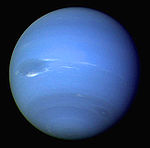- Great Dark Spot
-
The Great Dark Spot (also known as GDS-89[1]) is the name given to a series of dark spots on Neptune similar in appearance to Jupiter's Great Red Spot. The first one was observed in 1989 by NASA's Voyager 2 probe. Like Jupiter's spot, they are anticyclonic storms. However, the interiors of Great Dark Spots are relatively cloud-free, and unlike Jupiter's spot, which has lasted for hundreds of years, their lifetimes appear to be much shorter, forming and dissipating once every few years or so. Based on observations taken by Voyager and since then with the Hubble Space Telescope, Neptune appears to spend somewhat more than half its time with a Great Dark Spot. Almost all that is known about Neptune is based on the research carried out by the spacecraft Voyager 2.
Contents
Characteristics
The dark, elliptically-shaped spot (with initial dimensions of 13,000 × 6,600 km, or 8,100 × 4,100 mi) was about the same size as Earth, and was similar in general appearance to Jupiter's Great Red Spot. Around the Great Dark Spot, winds were measured blowing up to 2,400 kilometers (1,500 mi) an hour, the fastest in the Solar System. The Great Dark Spot is thought to represent a hole in the methane cloud deck of Neptune. The spot was observed at different times with different sizes and shapes.
The Great Dark Spot generated large white clouds at or just below the tropopause layer[2] similar to high-altitude cirrus clouds found on Earth. Unlike the clouds on Earth, however, which are composed of crystals of ice, Neptune's cirrus clouds are made up of crystals of frozen methane. And while cirrus clouds usually form and then disperse within a period of a few hours, the clouds in the Great Dark Spot were still present after 36 hours, or two rotations of the planet.
Neptune's dark spots are thought to occur in the troposphere at lower altitudes than the brighter upper cloud deck features.[3] As they are stable features that can persist for several months, they are thought to be vortex structures.[4]
Disappearance
When the spot was to be photographed again in November 1994 by the Hubble Space Telescope, it had disappeared completely, leaving astronomers to believe that it had either been covered up or vanished. The persistence of companion clouds shows that some former dark spots may continue to exist as cyclones even though they are no longer visible as a dark feature. Dark spots may dissipate when they migrate too close to the equator, or possibly through some other unknown mechanisms.[5]
However, an almost identical spot emerged in Neptune's northern hemisphere. This new spot, called the Northern Great Dark Spot (NGDS), has remained visible for several years.[6]
See also
References
- ^ Hammel, H. B.; Lockwood, G. W.; Mills, J. R.; Barnet, C. D. (1995). "Hubble Space Telescope Imaging of Neptune's Cloud Structure in 1994". Science 268 (5218): 1740–1742. Bibcode 1995Sci...268.1740H. doi:10.1126/science.268.5218.1740. PMID 17834994.
- ^ Stratman, P. W.; Showman, A. P.; Dowling, T. E.; Sromovsky, L. A. (2001). "EPIC Simulations of Bright Companions to Neptune's Great Dark Spots" (PDF). Icarus 151 (2): 275–285. Bibcode 1998Icar..132..239L. doi:10.1006/icar.1998.5918. http://www.lpl.arizona.edu/~showman/publications/stratman-etal-2001.pdf. Retrieved 2008-02-26.
- ^ S. G., Gibbard; de Pater, I.; Roe, H. G.; Martin, S.; Macintosh, B. A.; Max, C. E. (2003). "The altitude of Neptune cloud features from high-spatial-resolution near-infrared spectra" (PDF). Icarus 166 (2): 359–374. Bibcode 2003Icar..166..359G. doi:10.1016/j.icarus.2003.07.006. http://cips.berkeley.edu/research/depater_altitude.pdf. Retrieved 2008-02-26.
- ^ Max, C. E.; Macintosh, B. A.; Gibbard, S. G.; Gavel, D. T.; Roe, H. G.; de Pater, I.; Ghez, A. M.; Acton, D. S.; Lai, O.; Stomski, P.; Wizinowich, P. L. (2003). "Cloud Structures on Neptune Observed with Keck Telescope Adaptive Optics". The Astronomical Journal, 125 (1): 364–375. Bibcode 2003AJ....125..364M. doi:10.1086/344943.
- ^ Sromovsky, L. A.; Fry, P. M.; Dowling, T. E.; Baines, K. H. (2000). "The unusual dynamics of new dark spots on Neptune". Bulletin of the American Astronomical Society 32: 1005. Bibcode 2000DPS....32.0903S.
- ^ "Neptune". Solarviews.com. http://www.solarviews.com/eng/neptune.htm. Retrieved 2011-09-28.
External links
- Neptune's Great Dark Spot of 1989, Windows to the Universe
- Neptune's Great Dark Spot: Gone But Not Forgotten, Astronomy Picture of the Day, May 8, 1996
Neptune Discovery 
Characteristics - Rings
- Great Dark Spot
- Small Dark Spot
- The Scooter
- Kuiper belt
Moons Exploration Trojans Miscellaneous Categories:- Neptune
- Planetary spots
- Vortices
Wikimedia Foundation. 2010.

